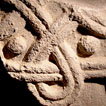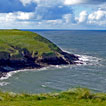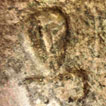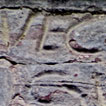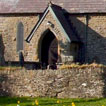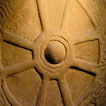The Age of the Saints
Christianity came to Britain while it was still under Roman rule, although we have very little evidence for it in South Wales. Some scholars have suggested that it only really took off here in the fifth century, as a way of for people to show that they were still 'Romans' even though Britain was no longer part of the Roman empire.
The period between the end of Roman rule and the Norman Conquest is difficult to study archaeologically: no pottery was being produced, and most objects that people used were either biodegradable or could be recycled, leaving few traces behind for us to recognise their presence. Hardly any secular sites have been identified. The situation is a little better when it comes to the church. Most of the written records that survive were drawn up by churchmen, either lives of the saints as an example to their flock, or to record their possession of land. One of the most useful documents is the Book of Llandaff. This was drawn up in the 12th century by Bishop Urban who was trying to press his claims to large amounts of land in South Wales, including the Marches on both sides of the border. The main part of it consists of transcriptions of earlier charters, which gives us a fair amount of information as to where a considerable number of pre-Norman churches were. Trying to match up this information on the ground, however, is difficult.
There are certain features that archaeologists look for when trying to recognise early church sites. Sometimes a clear connection can be shown between prehistoric or Roman features and a later church. We know from written sources that some pagan religious sites were deliberately taken over by the church. At other places, graves of people thought to be particularly holy in Roman cemeteries attracted other burials. Although such cemeteries did not start out containing churches, a church might be built later. In some areas, circular churchyards are particularly connected with an early foundation. Other indicators of a pre-Norman foundation include Celtic dedications or traditions of a saint's grave, nearby holy wells, some place-name elements like merthyr (shrine), or eglwys (church), or early medieval artefacts, in particular carved and inscribed stones.
It is the carved and inscribed stones that are the most visible evidence of the early church. These range from the simple pillar stones of the 5th-9th century engraved with the name of the person on whose grave they stood, and later with simple crosses. From the 9th century onwards, these monuments become increasingly elaborately carved, and include tall pillar crosses decorated with complex patterns as well as grave-markers with wheel-headed crosses and longer inscriptions. Unfortunately these stones are not distributed evenly. Hardly any have been found in Gwent, although we know from the written records that churches were as common there as they were in Glamorgan.
